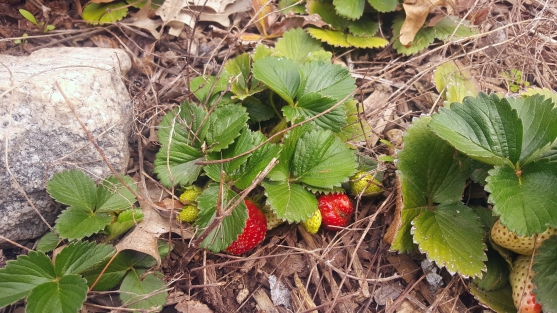 There is a reason most supermarket strawberries don’t taste all that great. They aren’t ripe when they are picked. Fix that problem by growing your own!
There is a reason most supermarket strawberries don’t taste all that great. They aren’t ripe when they are picked. Fix that problem by growing your own!
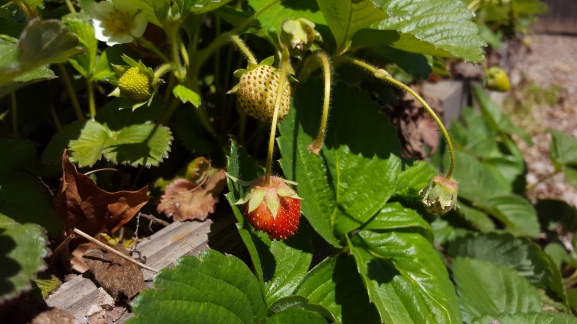 I have lived most of my life here in California’s Central Valley. Any drive out of town becomes a lesson in modern agricultural practices. One learns how to identify crop plants and harvest times as fields speed by the car window (that is, if you are actually looking out of it!).
I have lived most of my life here in California’s Central Valley. Any drive out of town becomes a lesson in modern agricultural practices. One learns how to identify crop plants and harvest times as fields speed by the car window (that is, if you are actually looking out of it!).
*A handy growing summary chart is at the end of the article.*
(All links open a new page, so you won’t lose your spot when you look around! Get information on gardening and cultural traditions, recipes, stories, and more!)
One thing that is also quickly learned is that many products have to be picked before they are fully ripe if they are to be able to survive the harvesting and shipping process. Sadly, strawberries are on that list. To avoid bruising and rotting, they have to be gathered while they are still green, which means they are also hard and flavorless.
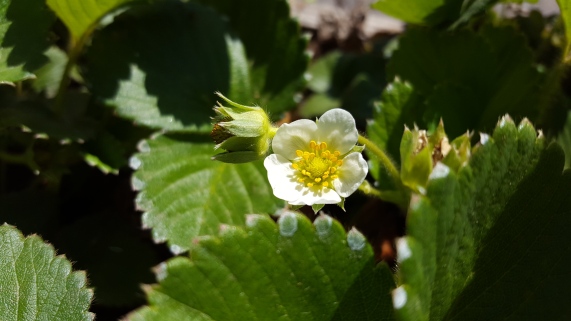 The best strawberries, then, are the ones that are picked at their peak of ripeness. You’ll find these at fruit stands where you actually see the fields they came from. I don’t even trust many farmer’s markets anymore. You can also find them in your own yard, or even your sunny balcony. Just look! See? There they are, because you’re going to plant them yourself!!
The best strawberries, then, are the ones that are picked at their peak of ripeness. You’ll find these at fruit stands where you actually see the fields they came from. I don’t even trust many farmer’s markets anymore. You can also find them in your own yard, or even your sunny balcony. Just look! See? There they are, because you’re going to plant them yourself!!
Strawberries are fairly hardy plants. They tolerate a wide range of zones, and are even somewhat drought tolerant depending on the variety. Here in zone 9, they get occasional freezes in winter and scorching heat in summer (110+ is not all that unusual anymore). When the colder temperatures set in, the leaves will turn red and eventually die back. It’s actually rather pretty because we get the red and green leaf mix right around Christmas time! The roots below ground will survive and regenerate new growth as the weather warms.
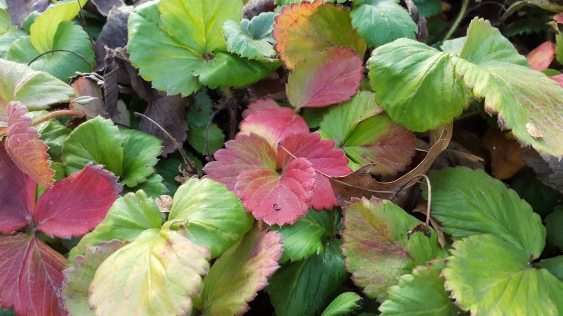
Strawberries can tolerate dry spells, but will produce more fruit with consistent moisture. However, they don’t like soggy soil so try to avoid heavy clay or overwatering. During hot spells, they will appreciate a little more water to help them through. Mulching the ground will work wonders in trapping moisture to help save water.
Make sure to also plant them where they will get maximum sunlight. Strawberries are easily grown in pots as well as in the ground, but keep in mind plants in pots tend to dry out faster than plants in the soil. You’ll want your soil to also be slightly acidic, and be a little higher in potassium for increased flower production and sweeter fruits. Again, plants in pots or raised beds may need a little more help maintaining these nutrients.
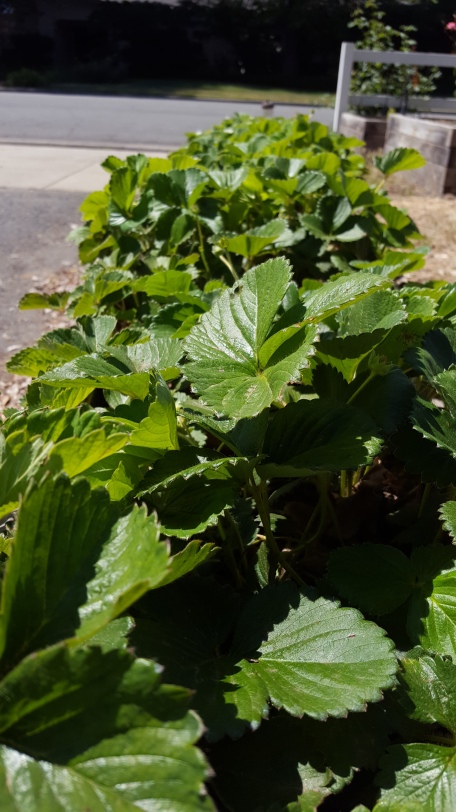 You will notice that for many varieties you will have a hard time finding seeds. That’s because they are hybrids that won’t produce seeds that are true to the parent’s traits. Since many types of strawberries send out runners (specialized stems that will form new plants when the tips reach desirable soil), you will really need only a few plants of a variety to eventually have a whole patch! Many growing sources will tell you to pluck off these runners as they supposedly drain energy from the parent plant and cause it to not produce as much fruit. While this is somewhat true, I have also found it near impossible to keep on top of this, so I gave up. I still get lots of fruit! If this is a concern for you, putting down a barrier like weed cloth or plastic mulch helps to deter the runners from successfully rooting. I have just decided to embrace the extra plants and the fruit they make! The plants formed from these runners will also be identical to the parent plant, unlike the seeds, since they are a product of asexual reproduction and are therefore clones.
You will notice that for many varieties you will have a hard time finding seeds. That’s because they are hybrids that won’t produce seeds that are true to the parent’s traits. Since many types of strawberries send out runners (specialized stems that will form new plants when the tips reach desirable soil), you will really need only a few plants of a variety to eventually have a whole patch! Many growing sources will tell you to pluck off these runners as they supposedly drain energy from the parent plant and cause it to not produce as much fruit. While this is somewhat true, I have also found it near impossible to keep on top of this, so I gave up. I still get lots of fruit! If this is a concern for you, putting down a barrier like weed cloth or plastic mulch helps to deter the runners from successfully rooting. I have just decided to embrace the extra plants and the fruit they make! The plants formed from these runners will also be identical to the parent plant, unlike the seeds, since they are a product of asexual reproduction and are therefore clones.
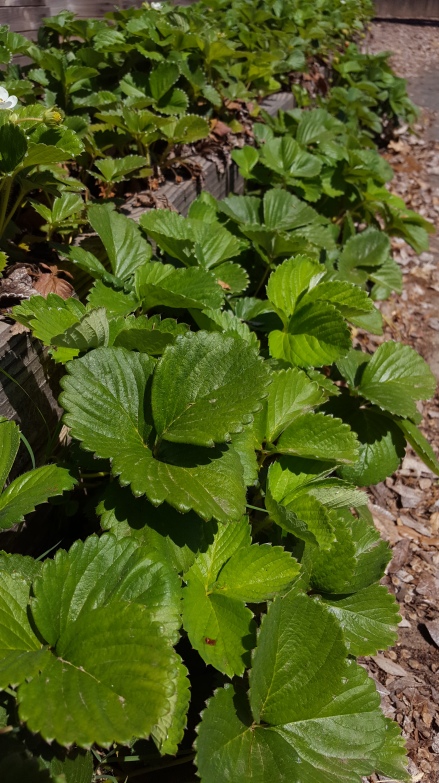
You will need to protect your plants from a handful of pests. Snails and slugs occasionally go after young leaves, but mostly they like the fruit. So do birds. So do roly-polies (aka “sow-bugs”, “potato-bugs”, etc.). These are the bugs that often roll up into a ball to defend themselves. Don’t fall for their cuteness, they can be incredibly destructive and will carve nice little holes into the bottom side of your fruits. Frequent harvesting will help keep these critters from having too much easy access, and will actually help increase production.
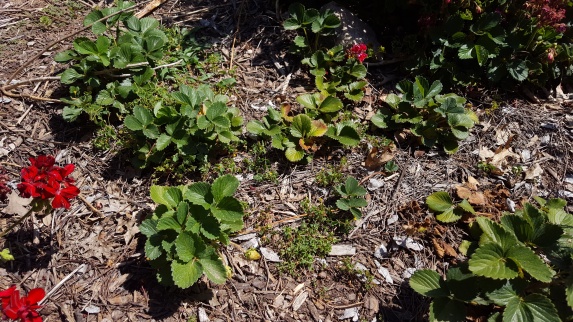
I recommend getting at least two varieties of plants for a couple of reasons. The first is that having multiple plants gives better opportunities for cross pollination and that tends to increase fruit production. The other is that there are different categories of strawberries based on when they produce fruit (in addition to different kinds). One type is the “June-bearing” or “early bearing” and as the name implies, they produce the bulk of their fruit in the late spring to early summer. For us it’s really “May-bearing”. We grow “Sequoia” for that early burst. The other main type is “everbearing”, and these will produce fruit throughout the summer months. We have “Ozark Beauty” and enjoy them for months on end. Having several of each type will give you a nice up-front harvest, and a steady supply after. This way you have plenty to eat fresh, and plenty leftover to store away for enjoying later on! What are some of the ways you enjoy fresh strawberries? Feel free to put your thoughts in the comment section below!
Plant Summary:
- Perennial: may die back in cold temperatures, may need to be grown as an annual in very cold zones
- Evergreen in warm winters
- Height: up to 1 foot
- Width: up to 1 foot, can spread as runners make new plants
- Sun: full sun
- Water: drought tolerant, produces better with more moisture
- Soil pH: 6-7
- Soil type: tolerates a wide range of soils, but won’t do well in loose sand or overly wet clay
- Key nutrients: ensure adequate potassium
- Planting time: best to start in cool spring after freeze danger has passed


Strawberries are so genetically modified and bloated anyway that they probably would not be very good even if allowed to ripen. The old fashioned cultivars that we grow in home gardens are much better, even if picked unripe, and much much better if ripened in the garden.
LikeLiked by 1 person
The modifications done to commercial strawberries is giving them an extra set of their own chromosomes. This makes plants in general bigger and more productive of fruits and flowers. I think even the strawberries grown at many fruit stands are the same, but allowed to ripen. The same is done with tomatoes. I’ll see trucks filled with green tomatoes going down the freeway every summer. No ripe tomato would ever survive the journey! And they both taste so much better when ripened in your own yard!
LikeLiked by 1 person
The apricots and prunes that grew in the abandoned orchards of the Santa Clara Valley were likewise nothing like those in the stores. The weird thing is that they are as marketable as they are. I have tasted apricots from a store, and would prefer canned apricots to fresh.
LikeLike
I think the practice of culling apricots and other stone fruits along with watering and other techniques has caused some less than desirable outcomes. Same with grapes, too. They are bigger, but are not more flavorful. They are really just taking the same amount of sugars and flavor compounds produced by the plants and diluting them with water-bloated size. I will cull some of my tree fuits (mostly my peaches) in order to limit the load on the branches and to grow larger sized fruit, but they are still no where near the size of the commercially produced ones. And, of course, the flavor is much better!
LikeLiked by 1 person
As you know, some of the best fruit comes from abandoned trees. (I certainly do not recommend abandoned trees; I am just making an observation.)
LikeLiked by 1 person